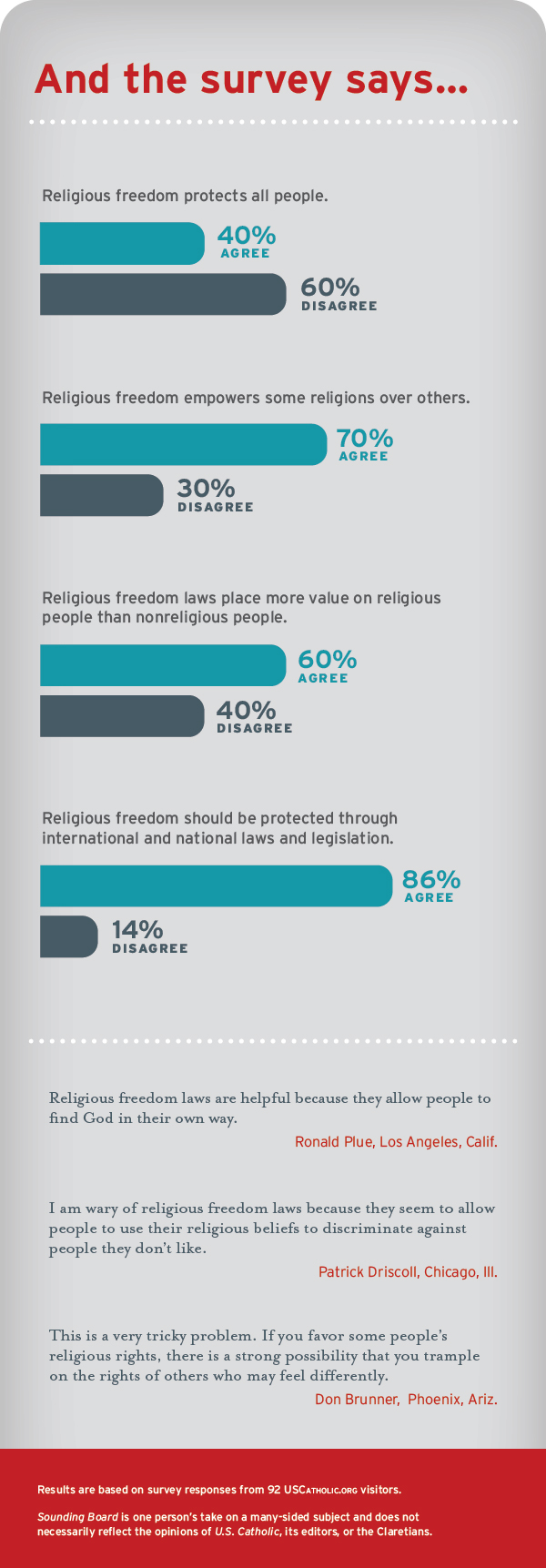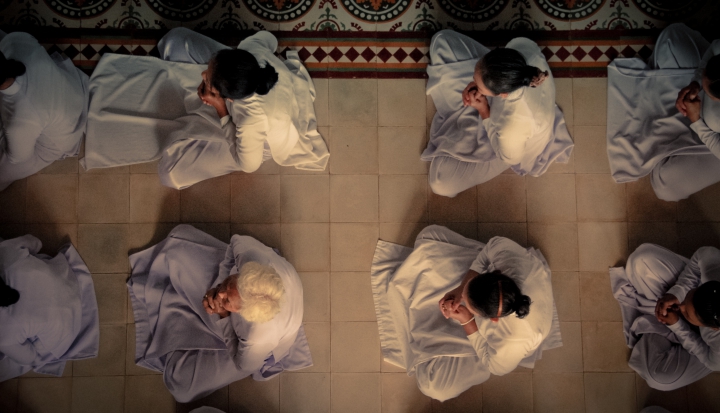I was always uncomfortable with the narrative that the United States invented and perfected religious freedom. I grew up in the Midwest, perched self-consciously between (and sometimes within) Catholicism and Judaism, with a parent from each tradition. I often found myself occupying the precarious spaces between religions and nonreligion, depending on where I was and with whom: at Mass with my beloved Catholic grandmother in rural Iowa; at the kitchen table at home in Minneapolis wondering if I should wish my thoughtful, agnostic Jewish father a “Happy Easter”; at school, where in fourth grade another child asked me, “What religion are you?” When I explained my situation, he responded, “But you do believe in Jesus, right?!” “Yes,” I answered nervously, not quite sure what that entailed.
Later in life I found myself deeply skeptical of any form of politics that created or highlighted religious-religious and religious-secular divisions. Being both diversely religious and yet, according to other definitions, completely nonreligious, my life experience cast into doubt any attempt to govern through the co-constitutive rubrics of either secularism or religion.
My daughter Sophie recently wrote a sixth grade report on the Puritans’ escape from religious oppression and pursuit of religious freedom in the United States. This story has been complicated by many modern historians, yet it remains untouchable in many quarters. Those who advocate for international religious freedom still draw on this myth to defend religious freedom around the world.
Foreign policy bureaucracies work to institutionalize safeguards for religious freedom, tolerance, and rights. Legal guarantees of religious freedom appear as riders in trade agreements. An outside observer might understandably conclude that religious freedom is a stable, fundamental human right, legal standard, and social fact that should be promoted globally. Many scholars, rights advocates, and religious leaders have fallen in line with this view, creating a chorus of voices that insists religious freedom leads to peace and prosperity. In one sense, international religious freedom is the civilizing discourse of our time. It is the new common sense.
The religious freedom movement draws on a combination of universal human rights discourse and an understanding of American history that posits the United States as exceptionally committed to religious freedom. This narrative, anthropologist Talal Asad reminds us in an article on human rights, is part of an enduring American prophetic tradition in which democracy, freedom, and human rights are seen as “integral to the universalizing moral project of America—the project of redeeming the world—and an important part of the way America sees itself.”
Religious freedom, American-style, globalizes this narrative of national redemption. It is not only a legalistic but also a powerfully affective political language of reform and renewal. During the Cold War the United States sought to secure “global spiritual health” to combat communism. Today we promote religious freedom.
However religious freedom is a more problematic ideal than it might seem. For one, the practice of religious freedom prioritizes religious people and communities. North American and European governments, military and intelligence services, development agencies, and a burgeoning religion bureaucracy have adopted religion as a category to draw together individuals and communities as corporate bodies needing legal protection to achieve their freedom.
Privileging religion as an object of governance means that whatever the authorities designate as religion assumes special political significance. Marks of distinction between religions and between religious and secular life are invested with political and legal significance. Judges are called on to determine what counts as a religion and to distinguish between orthodox and unorthodox forms of it. Boundaries that are supposed to be softened or transcended as all religions are protected are retrenched and reinforced. A number of questions are elided, lost in the shadow of a powerful emancipatory discourse: Whose understanding of which religions are protected? Whose understandings of which freedoms?
The Rohingya of Myanmar, a stateless people persecuted by the Burmese government, illustrate this dilemma. The religious freedom lobby and much of the international media claim the Rohingyas’ lives are miserable because they’re Muslim and most Burmese don’t like Muslims. It is religious intolerance that motivates the violence, and the solution is religious freedom. And yet the Rohingya are caught in a complex web of discriminatory ethnic, racial, economic, religious, and statist forces. It is impossible to disentangle these factors.
Putting the accent on religious identity stabilizes the Rohingya’s public representation as Muslims while downplaying their identities as Burmese citizens and as human beings with multiple affiliations. It also bolsters the narrative of a violently exclusionary Burmese Buddhist nationalist movement that critics have compared to the Ku Klux Klan and that is calling for the comprehensive social, economic, and political exclusion of the Rohingya from Burmese state and society.
Politicizing the Rohingya’s religious identity strengthens rather than saps their oppressors. The Rohingya should be included in society as humans, not only as Muslims. Marking religious difference as the most salient aspect of this crisis empowers the violent extremists who depend on hard and fast lines dividing Muslims from Buddhists and forms strong connections between majoritarian (Buddhist) religion, race, and Burmese nationalism.
This is the tragedy of religious freedom. In positing discrete religious identities and communities as the defining feature on a political landscape, it contributes to the politicization of religion and the deepening of the lines of division it is meant to tame or transcend. It lends authenticity to groups that the authorities designate as religious. It enlivens religious-religious and religious-secular distinctions. It contributes to a socio-political landscape defined by religious difference, ripe for exploitation by those who profit most from such divisions.
What falls under the heading of religion is a complex and shifting mash-up of diverse families of beliefs, institutional forms, and fields of practice and experience. Religion often merges seamlessly with other parts of life. Many forms of religion fit uncomfortably or not at all into an understanding of religion as a singular, bounded “cause” of behavior.
The drive to globalize religious freedom empowers some religions over others. It creates a hierarchy between the religion singled out for engagement and the rest of the world’s religion and nonreligion. It distills a complex field into something governable, squeezing an unwieldy set of human goings-on into the mold of whatever the authorities define as religions deserving of protection. The result is the production and policing of a series of divisions between official, sanctioned religion and the rest of world’s religion and nonreligion—including ways of life that may be considered sacred by the communities involved but that don’t officially count as religious. The rationale behind such designations is complex, idiosyncratic, and contextually specific. Many indigenous practices fall between the cracks. So do religions that have fallen out of political favor, including, most recently, many forms of Islam.
For example, after the fall of the Soviet Union, writes anthropologist Mathijs Pelkmans, religious freedom and market liberalization entered post-Soviet Kyrgyzstan under conditions that strongly favored Christian missions, many of them American. This free market model sanctioned particular ways of being religious that were understood to be modern and free. Particular religions the Kyrgyz authorities—working with the United States—deemed to be free, orthodox, and unthreatening were privileged. Other ways of relating to community, place, and tradition, including Muslim reformists and Orthodox Christians, were rendered unintelligible or even threatening.
The ubiquity of religious freedom talk ensures that powerful forces, including the law itself, encourage individuals and groups to make claims for equality, inclusion, and justice in the language of religious rights. Those who are uncomfortable with the demands of dividing the world into religious and secular become invisible, their voices drowned out in the chasm between the two. Others conclude they have no alternative but to seek protection on these grounds, resulting in new forms of religious agency and voices, even as those who cannot or will not speak in a sanctioned or orthodox religious register also fall silent.

This article also appears in the May 2018 issue of U.S. Catholic (Vol. 83, No. 5, pages 32–35).
Image: Kevin Bluer on Unsplash












Add comment